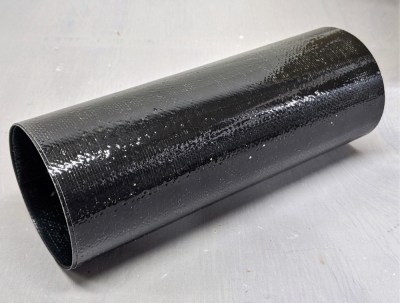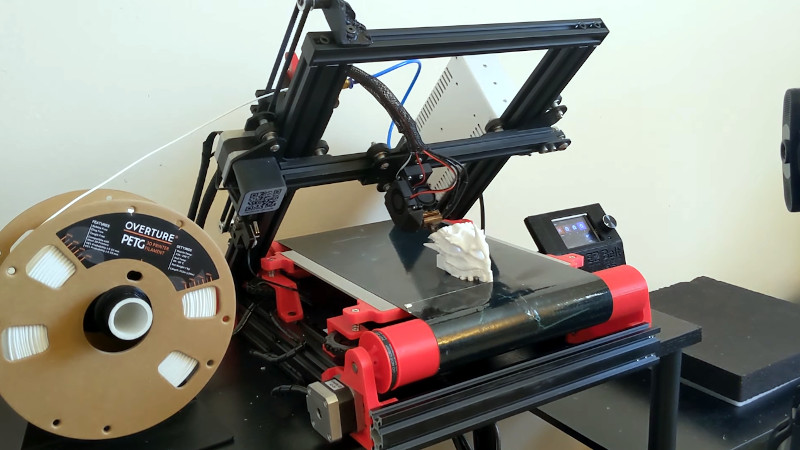It’s taken years to perfect them, but desktop 3D printers that uses a conveyor belt instead of a traditional build plate to provide a theoretically infinite build volume are now finally on the market. Unfortunately, they command a considerable premium. Even the offering from Creality, a company known best for their budget printers, costs $1,000 USD.
But if you’re willing to put in the effort, [Adam Fasnacht] thinks he might have the solution. His open source modification for the Ender 3 Pro turns the affordable printer into a angular workhorse. We wouldn’t necessarily call it cheap; in addition to the printer’s base price of $240 you’ll need to source $200 to $300 of components, plus the cost of the plastic to print out the 24 components necessary to complete the conversion. But it’s still pretty competitive with what’s on the market.

We imagine the elongated nozzles (which are necessary to get close to the angled bed) wouldn’t be too bad to make yourself if you’ve got the right equipment. But [Adam] says it took over two years to develop his Formula32 belt, so you might have your work cut out for you if you’re looking to produce something similar in-house.
We had high hopes for early contenders like the Printrbelt, but perhaps those early attempts were simply ahead of their time. With so many cheap 3D printers on the market these days to build off of, we may be on the cusp of a belt-printer renaissance.

















Cool. Anyone got an Ali search query for the belt?
https://powerbelt3d.com/product/formula32-custom-size-conveyor-belt/
“It uses a Polyester (PET) tape top-layer that works very well with a variety of 3D printing materials.”
Underlayer looks like fiber (glass? carbon?). Speculate wildly.
The modified / pointy nozzles that he sells make sense as well, given that you’re printing at an angle. My bet is that you could easily DIY both if you wanted to.
But why bother printing at an angle? I must be missing something.
Instead of artisinal, hand-tooled printer nozzles, just *angle the extruder head* so that it’s normal to the build surface, yeah?
The belt would allow for sequential prints. The angle however allows you to print beyond the bed. This allows for things like RC plane wings etc.
There already is another one – the tigtak project, which is a kit to convert a crailty to an angled belt printer
The cr30 belt is a reasonable and available alternative, I believe the other belt conversion mod out there uses it.
If the belt is truly some proprietary material (which I doubt) is it really open source?
“How can it be open source unless I can diy my own stepper motors”. Just because you can’t put everything together from a pile of rocks doesn’t make it closed.
If you designed a 3d printer would the stepper motors be the part that makes it new and unique?
If someone bought the belt but designed their own printer using the belt would that same belt not be the main interesting part of the new printer?
Something is either open source or not, you cant make something partially open source (well you can but then it’d just be closed source with a few open components). Hiding details on a critical component so you can sell your secret sauce imo precludes this from being considered open source as it violate core tenets of its ideology.
“How can it be open source unless I can diy my own stepper motors”
As long as the specifications are available, you can replace Bobs Custom Stepper Motor with a COTS clone or even a self-built part. If the specifications are not available and you must use the super-secret whuffie-coated unicorn-belt, then it’s not open source.
most printers use NEMA mount stepper motors, which are a standard part that follows an open standard.
But also, yes, you can diy your own stepper motors https://www.thingiverse.com/thing:1362555
My take is: “is it really open source if you can only get the parts from one place?” If stepper motors were only available from one vendor then their use would be less prolific.
Stepper motors are not provided by a single global vendor. You can take your pick.
And should you like to spend your time doing so, you can *absolutely* diy your own steppers.
So it is now a Neverender?
Underrated comment.
I love that!
Because it looks like a carbon fiber roll (which probably incurs most of its real cost) covered with PET, I tried searching for “carbon fiber cloth” and “PET film”. I also looked for “pet belt” without success, obviously :b .
The real problem is how to bind the cloth and the film, and how to have the surface roughness of the film (not the roughness of the cloth)
https://www.creality3dofficial.com/products/belt-kit-for-cr-30
Clever 👍
Sorry in advance for the negativity.. There are three 3-D printing articles on the hackday front page. I would prefer this blog not evolve into 3-D Printing Central.com.
How dare hackaday cover various hardware hacks….
I don’t think that will happen to HaD; although we may get “a run” on certain subjects, other hacks pop up that change “our” focus.
Squirrel!
Are you going to be ok? Maybe you should ask for a refund.
Sounds like someone is jealous and needs to go build or buy their own 3d printer.
Then my best suggestion is to submit projects that you are interested in to get the ball rolling in a certain direction. There’s submit button at the top of every page here.
Oh no! Your preferences!
“why bother printing at an angle”
Because otherwise you’ll run into your print. Remember, with large prints you don’t print the entire first layer and then move up, you need to come from the side (or at a 45 angle to be more precise) in order to be able to print the whole thing.